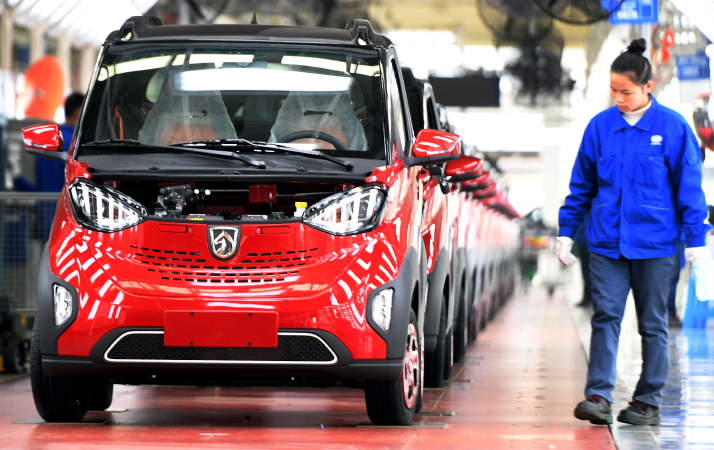| Business |
| Missing the Boat | |
| Why the U.S. approach to trade with China must change | |
|
|
 Workers examine new-energy vehicles rolling off the production line at an SAIC-GM-Wuling factory in Liuzhou, Guangxi Zhuang Autonomous Region, on January 23, 2017 (XINHUA)
 What do all these products have in common: phones, healthy juices, lipsticks, soybeans, vitamins, king crabs, vintage sneakers and BMWs? What do all these products have in common: phones, healthy juices, lipsticks, soybeans, vitamins, king crabs, vintage sneakers and BMWs? They are all produced in the United States and are being consumed on a massive scale in China. But their popularity, sales and consumption are all now being threatened by the ever-increasing number of tariffs placed on U.S. goods by China in response to tariffs placed on Chinese exports to the United States. There are likely to be two major unintended consequences of a U.S. trade war on China. First, companies' loss of access and sales to Chinese consumers at a time when they are consuming more Western goods (and everything else) than ever before. And second, the effect one tariff on one product can have on a range of U.S. industries. It is no coincidence that as global trade has expanded over the last one and half centuries, especially in the last 50 years, prosperity has risen and poverty has receded in almost every part of the world. The idea being propagated by some in Washington these days—that trade is a zero-sum game with winners and losers and that free trade hurts the U.S. economy—is demonstrably false. In a trade war with no winners, China will also feel its fair share of pain and suffering in the short term. The effect on some Chinese workers, farmers, businesses and exporters is real and bottom lines will be hurt. But we are not going to examine the bigger global implications of tariffs and the trade war or the potential downsides in China, but rather we are going to analyze the potential lost opportunities for U.S. companies in China and the effects that the tariff war is already having on U.S. workers and farmers. There has never been a better time for U.S. companies and brands to be engaging Chinese consumers and businesses. The current trade war could not come at a worse time. The situation threatens to derail decades of increasing sales of U.S. goods to China and may permanently damage the future appeal of "Made in USA" in the market. China's consumer economy Trade wars have no winners. The U.S.-China dispute is a problem unto itself, but the trade war is now growing into a global issue that could portend a complete realignment of global trade and the institutions that support it. And it will not be for the better for the United States. The numbers are staggering to those not familiar (and still to those of us familiar) with China's evolution from factory of the world to consumer market of the world. China's middle class is now more than 350-million strong and expected to be 550 million in less than 10 years. There are more than 650 million online shoppers—more than double the U.S. population—and more than 700 million Chinese with the disposable income to support a consumer economy. Urbanization and continued economic progress mean that it is likely there will be 1 billion consumers with significant disposable income and close to 900 million digital shoppers in 10 years or less. Driven by the evolution of digital commerce, smart mobile device ubiquity and a rapidly developing New Retail landscape, China's super consumers are pushing growth and profits for U.S. and other foreign brands and are resetting the way the world thinks about selling, buying and experiencing retail. New Retail was born in China and is now going global. The integration of online-offline logistics and technology as created by the titans, Alibaba, JD.com, Tencent, Baidu, NetEase and Suning, to name a few, has made it easier than ever for brands to sell to all of China's citizens, and for consumers to buy products from around the world in a way not possible even five years ago. The titans of Chinese retail, technology and logistics have made the dream of 1 billion customers a reality for both domestic and foreign companies. Profit driver The annual report released by the U.S. Chamber of Commerce in China showed that 73 percent of surveyed U.S. businesses posted profits in China in 2017, with 74 percent of them planning to increase their investment in China, the highest proportion in recent years. For companies whose sales are flat or dipping at home and in other overseas markets, China has been a bright spot and a growth driver. For example, General Motors now sells more cars in China than in the United States. Starbucks is growing exponentially in China, which is now its second largest market, with 500 stores opening in 2018 and a new partnership with Alibaba. In the realm of cross-border e-commerce, makers of U.S. vitamins and supplements, cosmetics and body care, food and beverages, mother and baby products, and apparel and footwear are doing well. Cross-border e-commerce will be a $1-trillion industry in four years' time. Prior to the trade war escalating, estimates were that trade between China and the United States would make up between 40-50 percent of that total. During last November's Singles' Day shopping festival, more than 30 percent of Alibaba's total sales of $25 billion were foreign products, with the United States, Japan and Germany the top three. Affordable luxury brands like Apple, Nike and others are doing well. But then again so are many European, Japanese and Korean brands.  A customer in Hong Kong (center) shows off the Alaskan King Crab she bought for 1 yuan ($0.15) at a promotional event organized by Alipay, the third-party payment service provider offered by Alibaba, on December 12, 2017 (XINHUA) Choosing alternatives Chinese consumers are now among the most sophisticated and discerning in the world. It is this very savviness that has led them to discover, enjoy and be loyal customers of U.S. products and brands. China's digital commerce giants have dedicated themselves in part to the "made in the West, bought in the East" model of business. At this very moment it is becoming easier and easier not just for multinationals and big companies to engage Chinese consumers, but farmers, entrepreneurs and small and medium-sized enterprises as well. At the same time, it is easier for farmers, entrepreneurs, and companies of all sizes, from anywhere in the world to sell their goods in China. When U.S. goods are priced out, locked out or suffer from national interest brand and purchase decisions, it's not just a brand that is hurt, but entire U.S. business ecosystems. According to the Distilled Spirits Council, a U.S. industry trade group, U.S. exports of distilled spirits to China grew 1,200 percent between 2001 and 2017. That growth rate was on course to increase significantly in the next five years. In a move to counter U.S. tariffs on hundreds of Chinese-made goods, a new 25-percent tariff was placed on U.S. whiskey and bourbon entering China. This is a case study in two ways. Chinese consumers will not stop drinking whiskey, they may simply buy less expensive whiskey produced in other countries such as Canada, Japan or Scotland, and as far as bourbon goes, they may shift to alternative spirits. More importantly, the longer-term and higher impact negative consequences go far beyond a loss of sales for a few quarters or even years. The bigger issue is how this single product category, caught up in a trade war, will damage support industries, workers, farmers, along with the USA brand and the U.S. economy. The general outline of the situation is as follows: Due to the tariffs, U.S. whiskey brands are now being forced to raise their prices in China, as well as in the European Union, Canada and Mexico. Even with the price increases, they cannot make up the full amount of the tariffs, which means they absorb these costs. This in turn means the following:
Thus, the consequences are the loss of a potential of a $1-billion customer base, isolation in a global cross-border retail world and a trail of damages to local economies. Where does this lead us? U.S. companies are now starting to push back. They are raising their voices and letting it be known that tariffs and trade wars are bad for everybody, but perhaps, in the end, especially for them. The U.S.-China bilateral trade, cultural and political relationship is now and will be for some time the most important on earth. The bilateral trade relationship has been a net positive for both countries. It has never been perfect and never will be, but then again, these things never are. It's time that U.S. businesses, financial institutions, politicians, workers and farmers begin the process of dialing back the trade war and finding new solutions to old problems, before it's too late. The author is Vice President of China/Asia Pacific strategy and global digital practices at consulting firm Tompkins International Copyedited by Rebeca Toledo Comments to zhouxiaoyan@bjreview.com |
|
||||||||||||||||||||||||||||||
|